|
Valve Train Problems 3
3-14-14
| An Unexpected Problem
Once I had the heads and the rev-kit out of the way, I
was able to remove and inspect the remainder of my valve train. As I
started pulling my roller lifters out things were looking pretty good...
till I got to the third or fourth ones. Once I had the first bad lifter
in my hand for an up close and personal look, all I could say was, "what
the hell"??!! The damage to this lifter was another eye opener (as I
once again shake my head from side to side). And again I had to ask
myself, "how did this happen"? Yeah I was talking to myself all alone in
the garage.
Now don't tell me that you've never talked to yourself while being
alone....yeah...that's what I thought.
The single lifter by it's self in the back is for reference because
it's a good one. On the other hand the other four didn't fare so well.
|
|
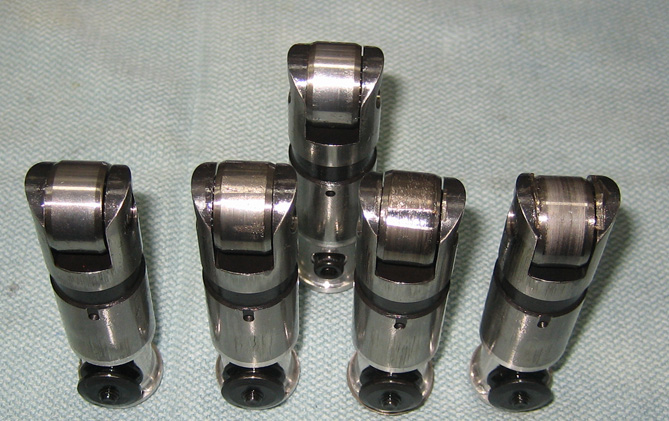 |
|
Look at the middle one with that huge groove across the middle of the
roller. The only thing I can think of that would cause this would be for
the bearings to have failed internally which made the roller stop
moving. If that was the case then I could see the lobe of the cam might
have beaten that groove into the roller but I'm not sure.
You can also see the one on the left was rolling intermittingly to
have a ware pattern like it has. Probably another bearing failure. Now
the one on the right has had some kind of failure as well because the
roller is well below the outer surface.
|
|
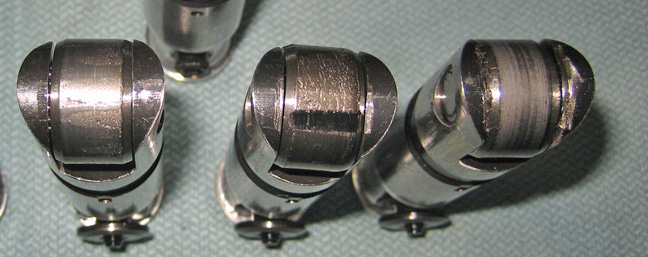 |
|
Here is a better look at the right hand lifter that now has the roller
below the surface. The one on the left is what it should look like.
Truly unreal. And again, the engine didn't run that bad is what gets me.
Now if these lifters look this bad...what does my camshaft look like???
Spoiler alert here...it didn't look good. At least from what I could
see of it through the lifter bores. Once I rolled the engine around and
looked at each lobe with a flashlight, it definitely wasn't good news.
I sat down with my hand against my forehead with only my finger tips
and thumb touching the left side of my head, eyes shut, face looking at
the ground and shaking my head from side to side again in disgust. I was
trying to take it all in while sitting there and all I could do was
think about how bad the cam looked and what would need to be done to fix
it.
I opened my eyes, got off the chair, walked over to the car, got out
my flashlight again and took a second look. I rolled the engine over one
more time and right then I knew what I had to do, the cam would need to
come out. If it looked that bad through the lifter bores, then I could
only imagine how it would look up close. Son-of-a-bitch!!
|
|
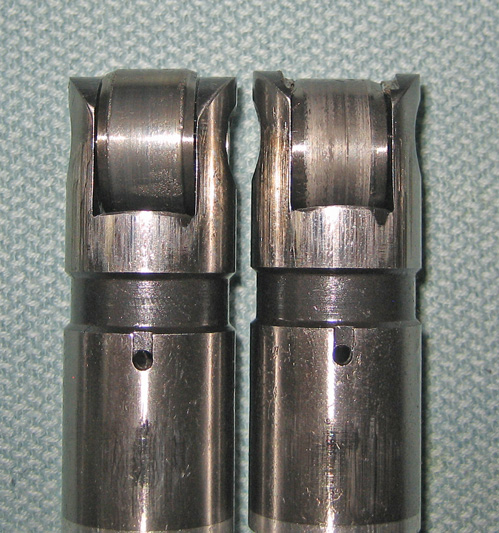 |
|
The next day I started the procedure of removing the camshaft. What does
it take to make that happen? It means I would have to remove the oil pan
(which is on the floor in this shot), the water pump, the radiator, the
bottom pulley and then the harmonic dampener would need to come off to
be able to remove the timing cover, which leads to the removal of the
timing set and then the cam can come out.
Now all this doesn't take that long, it's really the 'thought of
doing it' is what keeps me up at night. I also thought about taking out
the engine and be done with it but the thought of being under the car
for even longer, removing the entire exhaust system, the driveshaft, the
hydraulic clutch line and last but not least the transmission, I decided
against it. I figured if I found something else wrong along the way that
I didn't like once the oil pan was off, then I'd take the engine out.
Oh...remember at the beginning of the story about me changing the
oil? Well I didn't even go one mile on it. Once I removed the heads,
water filled some of the cylinders and once that happens, it will find
its way through the piston rings and into the oil pan. Antifreeze isn't
very kind to engine bearing material so I ended up throwing it all away.
And the filter as well :-[
|
|
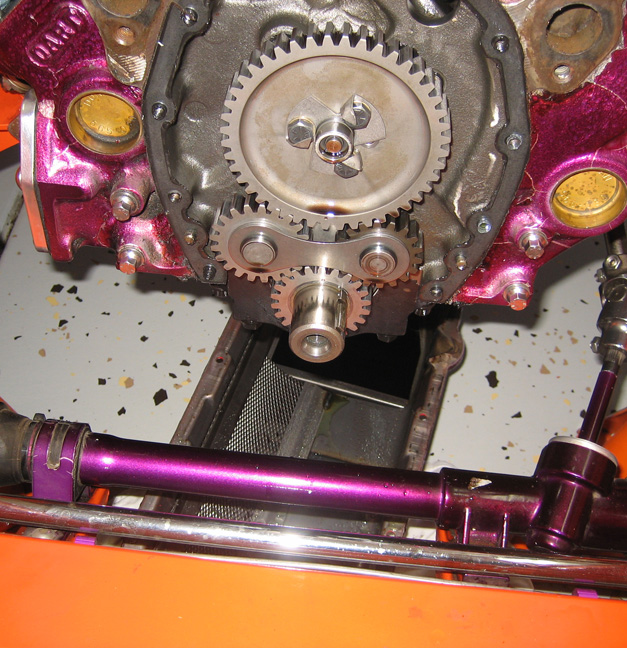 |
After a couple hours of disassembly, the camshaft was out. From here it
doesn't look that bad but if you come in for a closer look, that's when
things get depressing. Now if you had to guess how many lobes that were
bad, how many would it be? Read on to find out.
|
|
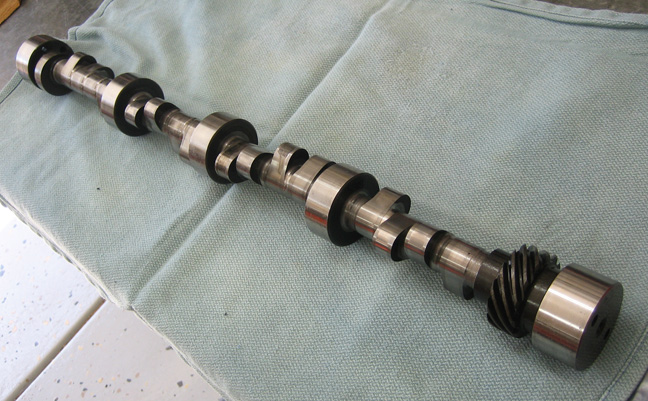 |
The two lobes that you see damaged here were really bad. But the ones
right next to them had normal wear and looked fine. Also note the deep
groove in them as well. I'm not sure what caused this but I'm pretty
sure the lifter failed first and wiped out the cam.
|
|
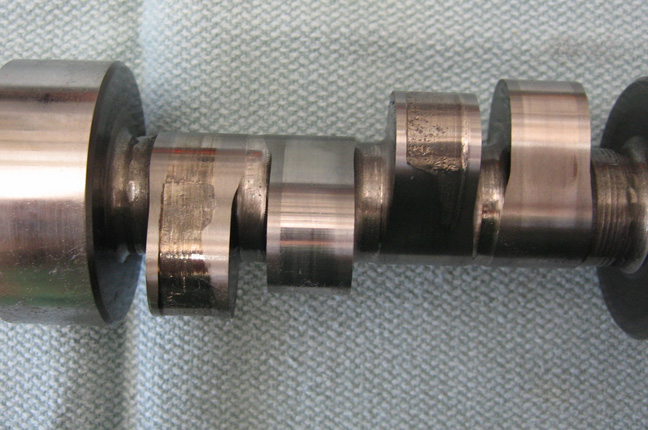
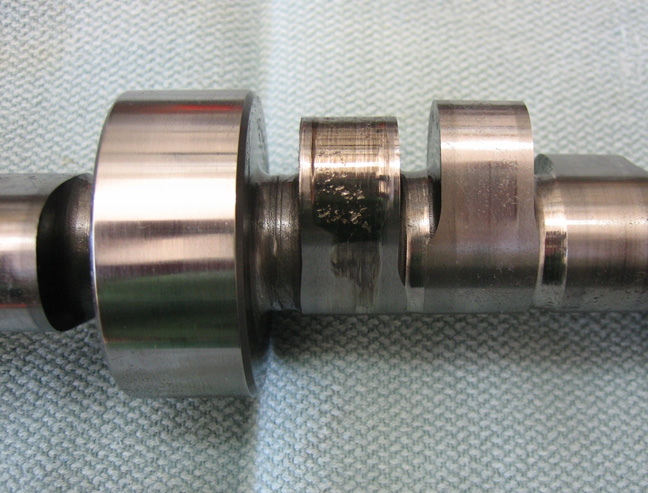 |
|
I'm gonna guess the reaction that you had as you were looking
at those pictures above was something like this: your mouth was open
making that "ooooohhh" sound, like when you see someone getting hurt and
you're glad it wasn't you. Well I don't blame you because it was painful
for me that's for sure. I ended up with three bad cam lobes in all, even
though I had four bad lifters.
I made a call to Iskenderian Racing Cams and talked to the same guy
that sold me this cam over 10 years ago. I told him my problem and he
said that they might be able to regrind my cam if the grooves weren't to
bad. He asked me how deep they were, but I didn't know so I told him
that I'd find out and call him back. So I went out to the garage and got
out my calipers to get a rough idea how deep the worst groove was. Now I
don't have anything to check the depth of the bad cam lobes compared to what Isky has, but I
think I could get close enough to know if it was savable or not.
The guy from Isky said that if the damaged area was .020 to .025 deep
then the cam was scrap. But if it was less than that, they could regrind
it to the same specs as before which gave me a little hope. I figured
the depth on the worst lobe to be .017 to .018 deep with my calipers. It was going to be
close.
Let me explain in a little more detail about all this: my cam is made
out of 8620 steel which has been heat treated or tempered. The type of
heat treatment for this kind of steel is called 'case hardening'. Case hardening is a process that hardens the outer surface of
the steel but the inner part is softer,
and is typical in the making of other engine parts like arbors, pinions,
king pins, ratchets, gears, splined shafts etc. can be made out of 8620
material and works very well. There are different depths to this type of
heat treatment which can vary from .010 to .080 deep. And in my
situation it looks to be an .080 case depth.
I called him back and told him what I found and after a few minutes I
told him I'd send it in for them to evaluate. The cost of the regrind is
about 1/3 the price of a new one so I didn't have anything to loose by
sending it to them. Now Isky also said they could rebuild my bad lifters
and the cost for that is about half price of a new ones. I packed one
cam and four lifters into a box and sent it to them.
A few days later he called me back and told me they found the cam to
be .019 to .020 deep on the worst lobes. Borderline at best. The procedure
here is that Isky would take my cam, regrind one or two of the worst
lobes, pull it off the grinder and then recheck the hardness of them. If
it checks good and into spec, that would be great but if it doesn't,
then it's no good and would be scrap.
I didn't think about this decision very long and told him to just
make me a new one so I didn't have to worry about it. This would give me
piece of mind and I had the option of using a cast iron cam gear on the
new one which they didn't have 10 years ago. The cast iron cam gear is
something they started doing a few years ago which means you can use
your stock distributor gear in place of using a bronze one like I had.
This was good news so I went with this option and I already have the
gear that came with my MSD distributor when I bought it new so that was
one part I didn't need to buy.
Now it's time to hurry up and wait so lets see what I've been doing
to keep busy.
|
|
1
2
3
4
5
6
7
8
9
10 |
|